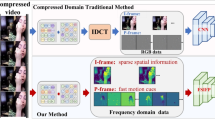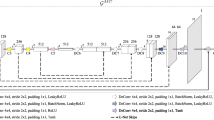Abstract
Distributed video coding (DVC) is desirable for encoding systems with tight power or computational constraints, for which the popular practical solution is transform-domain Wyner-Ziv video coding (TD-WZVC). To achieve the similar coding performance with H.264/AVC, quantization is a key factor in TD-WZVC. Practically, the quantization matrix is trained offline and remains fixed value during coding. Optimal rate-distortion (RD) performance cannot be achieved due to the varying quality of side information (SI) frame. In this paper, a novel model of perceptual distortion probability is developed to estimate the perceptual distortion of SI frame and to derive the target perceptual distortion. With the two perceptual distortion probabilities, three components (i.e. quality of SI frame, perceptual features and RD optimization) are integrated to determine the optimal quantization matrix adaptively, which improves the coding performance. Extensive experiments demonstrate that the proposed scheme can adaptively determine proper quantization matrix online and achieve similar visual quality with less bit-rate, as compared to other adaptive quantization schemes in TD-WZVC.











Similar content being viewed by others
References
(2000) Methodology for the subjective assessment of the quality of television pictures. ITU-R Rec. BT. 500–10, ITU-R, ITU
Aaron A, Zhang R, Girod B (2002) Wyner-Ziv coding of motion video. Asilomar Conf Signals Syst Comput
Artigas X, Ascenso J, Dalai M, Klomp S, Kubasov D, Ouaret M (2007) The DISCOVER codec: architecture, techniques and evaluation. Picture Coding Symp (PCS)
Ascenso J, Brites C, and Pereira F. A denoising approach for iterative side information creation in distributed video coding. IEEE Int Conf Image Process (ICIP) 3513–3516
Ascenso J, Brites C, Pereira F (2006) Content adaptive Wyner-Ziv video coding driven by motion activity. IEEE Int Conf Image Process (ICIP) 8–11
Brites C, Pereira F (2008) Correlation noise modeling for efficient pixel and transform domain Wyner-Ziv video coding. IEEE Trans Circ Syst Video Technol 18:1177–1190
Brites C, Pereira F (2011) An efficient encoder rate control solution for transform domain Wyner-Ziv video coding. IEEE Trans Circ Syst Video Technol 21:1278–1292
BritesC, Pereira F (2007) Encoder rate control for transform domain Wyner-Ziv video coding. IEEE Int Conf Image Process (ICIP) II-5-II-8
Chen ZZ, Guillemot C (2010) Perceptually-friendly H.264/AVC video coding based on foveated just-noticeable-distortion model. IEEE Trans Circ Syst Video Technol 20:806–819
Chen ZZ, Tan YP (2011) Frame-level quantization control for perceptual quality constrained H.264/AVC video Coding. IEEE Int Symp Circ Syst (ISCAS) 1231–1234
Chen JW, Zheng JH, Xu F, Villasenor JD (2012) Adaptive frequency weighting for high-performance video coding. IEEE Trans Circ Syst Video Technol 22:1027–1036
Chien WJ, Karam LJ (2009) Transform-domain distributed video coding with rate distortion based adaptive quantization. IET Image Process 3:340–354
Gu Z, Lin W, Xie S, Lu Z (2007) Wyner-Ziv video coding based on perception analysis. Int Conf Inf Commun Signal Process (ICICS) 1–5
HoangVan X, Jeon B (2012) Flexible complexity control solution for transform domain Wyner-Ziv video coding. IEEE Trans Broadcast 58:209–220
Honsch I, Karam LJ (2002) Adaptive image coding with perceptual distortion control. IEEE Trans Image Process 11:213–222
Kubasov D, Nayak J, Guillemot C (2007) Optimal reconstruction in Wyner-Ziv video coding with multiple side information. IEEE Multimed Signal Process Workshop (MMSP) 183–186
Li YP, Zhao DB, Ma SW, Gao W (2009) Distributed video coding based on the human visual system. IEEE Signal Process Lett 16:985–988
Lin C, Zhao Y, Zhu C (2008) Two-stage diversity-based multiple description image coding. IEEE Signal Process Lett 15:873–840
Liu Z, Cheng S, Liveris AD, Xiong Z (2004) Slepian-Wolf coded nested quantization for Wyner-Ziv coding: performance analysis and code design. IEEE Data Compression Conference (DCC) 322–331
Liu Z, Karam LJ, Watson AB (2006) JPEG2000 encoding with perceptual distortion control. IEEE Trans Image Process 15:1763–1778
Ma L, Ngan KN, Zhang F, Li SN (2011) Adaptive block-size transform based just-noticeable difference model for image/videos. Signal Process Image Commun 26:162–174
Naccari M, Pereira F (2011) Advanced H.264/AVC-based perceptual video coding: architecture, tools, and assessment. IEEE Trans Circ Syst Video Technol 21:766–782
Puri R, Majumdar A, Ramchandran K (2007) PRISM: a video coding paradigm with motion estimation at the decoder. IEEE Trans Image Process 16:2436–2448
Rebollo-Monedero D, Zhang R, and Girod B (2002) Design of optimal quantizers for distributed source coding. In: IEEE Data Compression Conference (DCC) 13–22
Slepian D, Wolf JK (1973) Noiseless coding of correlated information sources. IEEE Trans Inf Theor 19(4):471–480
Sofke S, Pereira F, Muller E (2009) Dynamic quality control for transform domain wyner-ziv video coding. EURASIP J Image Video Process
Sun YC, Tsai CJ (2012) Perceptual-based distributed video coding. J Vis Commun Image Represent 23:535–548
Varodayan D, Aaron A, Girod B (2006) Rate-adaptive codes for distributed source coding. EURASIP Signal Process J Special Section Distributed Source Coding 86
Wang Z, Bovik AC, Sheikh HR, Simoncelli EP (2004) Image quality assessment: from error visibility to structural similarity. IEEE Trans Image Process 13:600–612
Wang SQ, Rehman A, Wang Z, Ma S, Gao W (2013) Perceptual video coding based on SSIM-Inspired divisive normalization. IEEE Trans Image Process 22:1418–1429
Wei ZY, Ngan KN (2009) Spatio-temporal just noticeable distortion profile for grey scale image/video in DCT domain. IEEE Trans Circ Syst Video Technol 19:337–346
Wu B, Guo X, Zhao D-B, Gao W and Wu F (2006) An optimal non-uniform scalar quantizer for distributed video coding. IEEE Int Conf Multimedia Expo (ICME) 117–120
Wyner A, Ziv J (1976) The rate-distortion function for source coding with side information at the decoder. IEEE Trans Inf Theor 22(1):1–10
Xue Z, Loo KK, Cosmas J, Tun M, Feng L, Yip PY (2010) Error resilience scheme for wavelet video codec using automatic ROI detection and Wyner-Ziv coding over packet erasure channel. IEEE Trans Broadcast 56:481–493
Yang TW, Zhu C, Fan XJ, Peng Q (2012) Source distortion temporal propagation model for motion compensated video coding optimization. IEEE Int Conf Multimed Expo (ICME) 85–90
Yang XK, Zhu C, Li ZG, Feng GN, Wu S, N Ling (2002) Degressive error protection algorithm for MPEG-4 FGS video streaming. IEEE Int Conf Image Proc (ICIP) 737–740
Zamir R, Shami S (2002) Nested linear/lattice codes for structured multiterminal binning. IEEE Trans Inf Theor 48:1250–1276
Zhang YS, Xiong HK, He ZH, Yu SY, Chen CW (2011) Reconstruction for distributed video coding: a context-adaptive markov random field approach. IEEE Trans Circ Syst Video Technol 21:1100–1114
Zhang YX, Zhu C (2010) Adaptive coset partition for distributed video coding. Signal Process 90:2480–2486
Zhang Y, Zhu C, Yap K (2008) A joint source-channel video coding scheme based on distributed source coding. IEEE Trans Multimed 10:1648–1856
Zhao Y, Yu L, Chen ZZ, Zhu C (2011) Video quality assessment based on measuring perceptual noise from spatial and temporal perspectives. IEEE Trans Circ Syst Video Technol 21:1890–1902
Acknowledgments
This work described in this paper was supported by the NSFC (Grant No. 60972111, 61036008, 61071184, 61373121), Research Funds for the Doctoral Program of Higher Education of China (No. 20100184120009, 20120184110001), Program for Sichuan Provincial Science Fund for Distinguished Young Scholars (No. 2012JQ0029, 13QNJJ0149), and the Fundamental Research Funds for the Central Universities (Project no. SWJTU09CX032, SWJTU10CX08, SWJTU11ZT08).
Author information
Authors and Affiliations
Corresponding author
Rights and permissions
About this article
Cite this article
Zhang, L., Peng, Q. & Wu, X. Perception-based adaptive quantization for transform-domain Wyner-Ziv video coding. Multimed Tools Appl 76, 16699–16725 (2017). https://doi.org/10.1007/s11042-016-3947-4
Received:
Revised:
Accepted:
Published:
Issue Date:
DOI: https://doi.org/10.1007/s11042-016-3947-4




